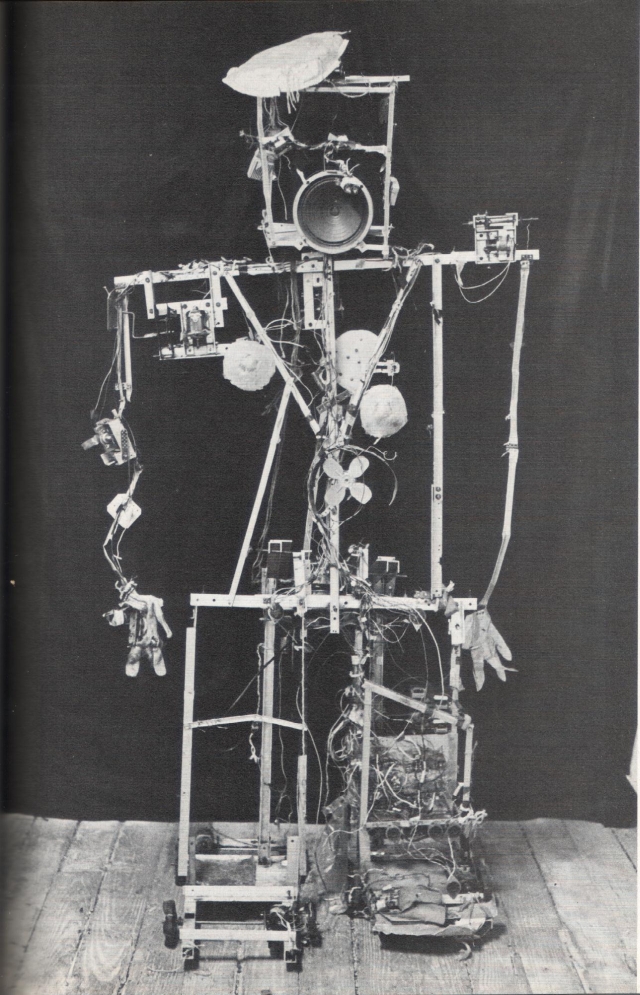
Title: Robot K-456
Creators: Nam June Paik and Shuya Abe. Japan, 1964. (Construction started in 1963 with Nam Jun and his brother and was completed in 1964 with the aid of Abe helping with the electronics).
Description: Originally intended to be a 30-channel radio-controlled robot,  but ended up as a 20-channel radio-controlled anthropomorphic robot. In anthropomorphic terms, the robot started out in life as being an androgyne*. In Japan, it had a sandpaper and flint penis. As some considered it bad taste, it was removed before going to America. After then, K-456 was said to be feminine.
*An androgyne in terms of gender identity, is a person who does not fit cleanly into the typical masculine and feminine gender roles of their society.
Commentary: Named after Mozart’s piano concerto (Köchel’s Catalogue number 456), the robot first performed in a private space (Robot Opera, at Judson Hall, in collaboration with Charlotte Moorman) and on the streets, both as part of the Second Annual New York Avant-Garde Festival. As Paik guided it through the streets, K-456 played a recording of John F. Kennedy’s inaugural address and excreted beans. K-456 is now in the Hauser and Wirth private collection, in Zürich. More Recent images suggest K-456 is now in the Flick Collection.
Dimensions: 6′ x xx” x yy “Â (185cm x xxcm x yycm)
From photos and descriptions, I’ve derived what are the most likely functions of Robot K-456 (1964 version)
1. Doffing of hat (alumimium foil pie plate) via electric motor.
2. Nodding of Head (motor at base of neck rotates wheel with cord attached).
3. Twin motor-propellor eyes.
4. Twin lamps for nose.
5. Rotate left breast.
6. Rotate right breast .
7. Body bow. A winding motor in the ‘pelvic’ area allows the top section to lean forward. With a combined head nod, K-456 was known to fall forward on occasion.
8. Raising of left arm .
9. Lowering of left arm.
10. Raising of right arm.
11. Raising of right fore arm.
12. Raising of right hand at wrist.
13. Abdominal electric fan (for naval).
14a. Defecating (dried, white beans). Mechanism appears to be located in the pseudo-anatomical position as a real person.
14b. Urinating (NJP “Sudden shower”; Jasia Reichardt said it “peed on the floor”.) It maybe the case that only one bodily function could be operated at one time. I’ve seen no mention of them operating together.
15. Walking action via rod crank in ‘hip’ area. Note there are also motors in the feet. If this is reversible, and another channel is required.
16. Activation of tape recorder (including speech recording of the then Mayor-elect of New York, John Lindsay). Another recording played back was John F. Kennedy’s 1961 inaugural address speech.) – Tape recorder may have been manually activated.
17. Rolling left-leg forward via motorised foot.
18. Rolling left-leg backward via motorised foot.
19. Rolling right-leg forward motorised foot.
20 Rolling right-leg backward motorised foot.
I cannot detect any sensors or limit switches. I’ve assumed that steering would have required a reversible motor in the feet.
There is also a 10-channel data recorder on board. Although I’ve seen no mention of it in operation, I suppose this is for re-play of commands to reproduce a performance, for example.
Beyond Modern Sculpture – Jack Burnham, 1968
Chapter Eight: Robot and Cyborg Art – p351
 Long a gadfly of the musical avant-garde, the Korean Nam June Paik demonstrated a semi-operative robot at an exhibition of electronic art in 1965. Paik, preparing his automaton in New York City, could be termed the Rimbaud of electronics. There is not so much technical expertise in his flirtation with cybernetic and communication theory as there is mastery of incantation : if the names of Rauschenberg, Wiener, John Cage and Marshall McLuhan are repeated with enough fervency and juxtaposed with random mathematical symbols then the age of the electronic humanoid plugged in for instant global communication will be upon us.
Aside from this, Nam June Paik’s chief creation, Robot-K456 with 20-Channel Radio Control and 10-Channel Data Recorder*, is the robot “stripped bare” of everything but her[sic] skeletal aluminum and components. Constructed of bolted right-angle channels mounted with muscle-simulating motor and cam units, a loudspeaker, sensory devices, wheels for walking, and a bank of electronic controls in her left leg, K456 responds listlessly to human intervention. Her pathos is that of Descartes’s man-machine—an ungainly collection of wheels, levers, and cogs updated to the tidy confusion of the radio chassis. If the reader remembers the flayed arm of the cadaver in Rembrandt’s Dr. Tulp’s Anatomy Lesson, the greenish-whitish illumination of the corpse, more real than the healthy observers surrounding the dissection table, then he will have some feeling for the electronic fragility of K456. As a cyborgian gesture Paik has added a pair of sponge-rubber falsies to his already well-equipped automaton.
*This descriptive title was first used in Paik’s first one-man show, at Bonino Gallery (1965).
VIDEO CLIP 1 of 2Â ACTION MUSIC IN BERLIN
3122.14 | ACTION MUSIC IN BERLIN (1:43:04:00 – 1:44:38:00) 1965
Nam june paik
West Berlin, Federal Republic of Germany (Western Germany).
Title in German reads ‘Unsinn du Siegst!’
Various shots of June Paik and Charlotte Moorman giving performance of action music in Berlin street and in a small club. It is referred to as nonsense! Woman makes various noises on cello while Asian man operates two[sic] hand made robots, small crowd looking on. A girl is American. In a small club she makes noises by using cello and breaking or hitting various objects. She breaks glass, talks, whistles, etc. People looking on. Man assisting her blows a balloon and another man pours water over his head.
Date found in the old record – 21/06/1965.
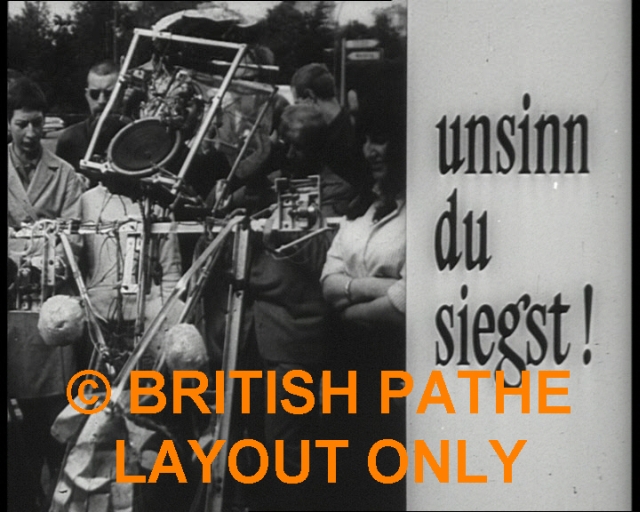

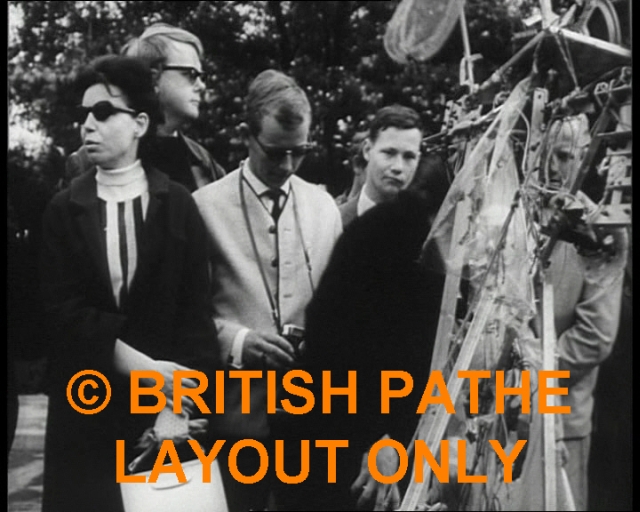

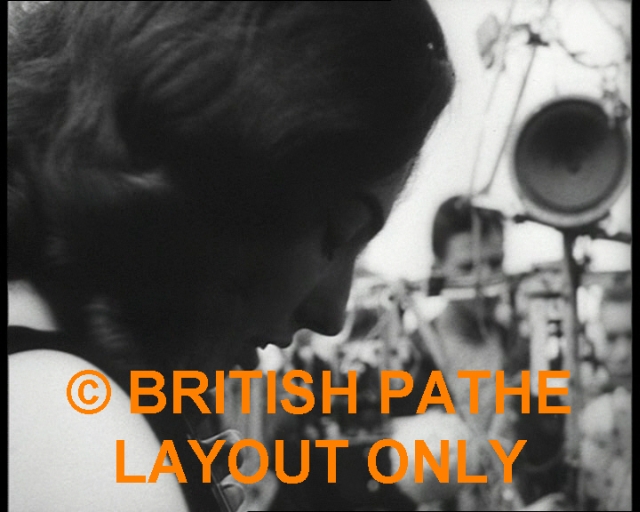
VIDEO CLIP 2 of 2. Movietone VIDEO CLIP link here. You will need to register first (free), then login. Search on Paik . Preview the video clip titled “THERE’S A MESSAGE THERE SOMEWHERE”.
Partial transcription of video: ‘Pop Art in Berlin. A robot, broadcasting what is pompously described as “instructions to humanity”. Can we be so lacking as we need a machine to give us guidance? Anyway, the robot needed a bit of guidance itself…..
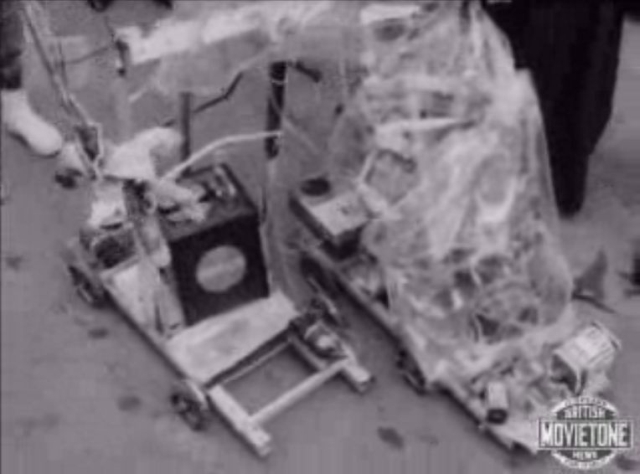



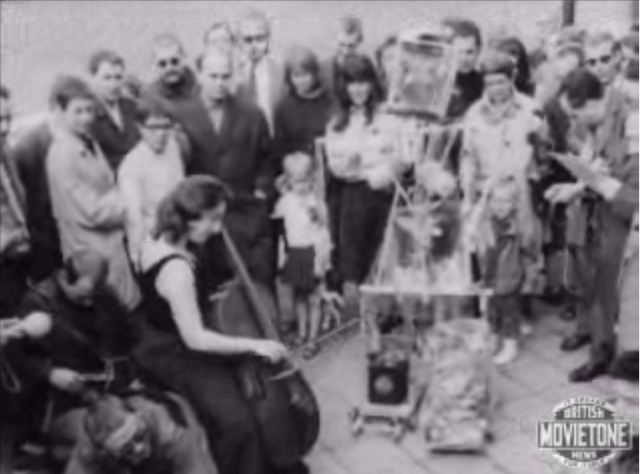
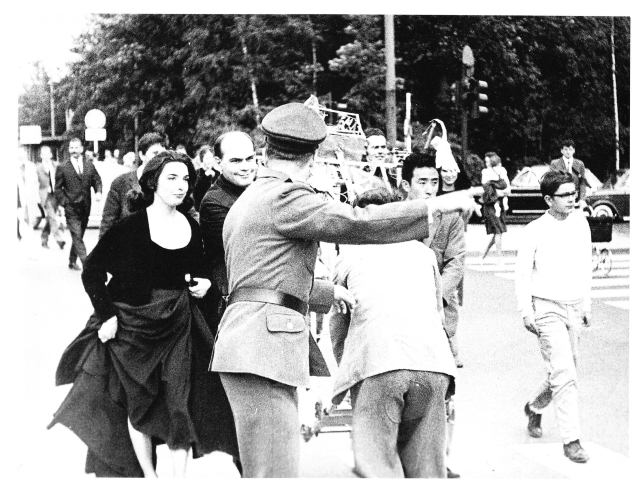
Robot Opera, 1965
Paik and Moorman trying in vain to perform in front of the Brandenburg Gate in Berlin, 1965. (Photo, Jürgen Müller-Schneck)



Nam June Paik with Charlotte Moorman and K-456. (Photo by Peter Moore at Paik’s Lispenard Street studio, Aug 17, 1964)
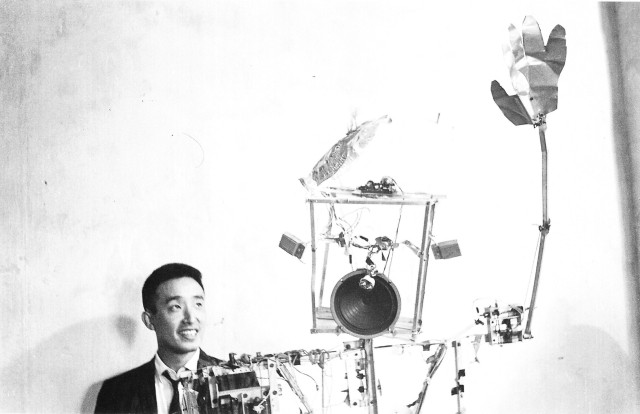
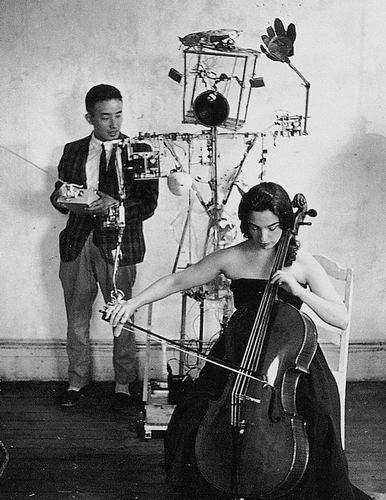
Publicity photos taken before Paik’s and Moorman’s first performance together, at the “Second Annual New York Avant-Garde Festival”, August, 1964.
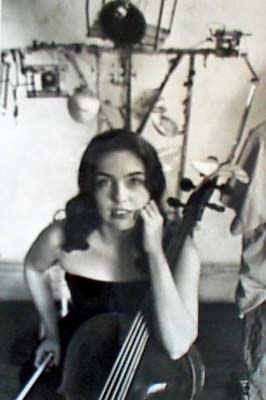
(above photos by Peter Moore)
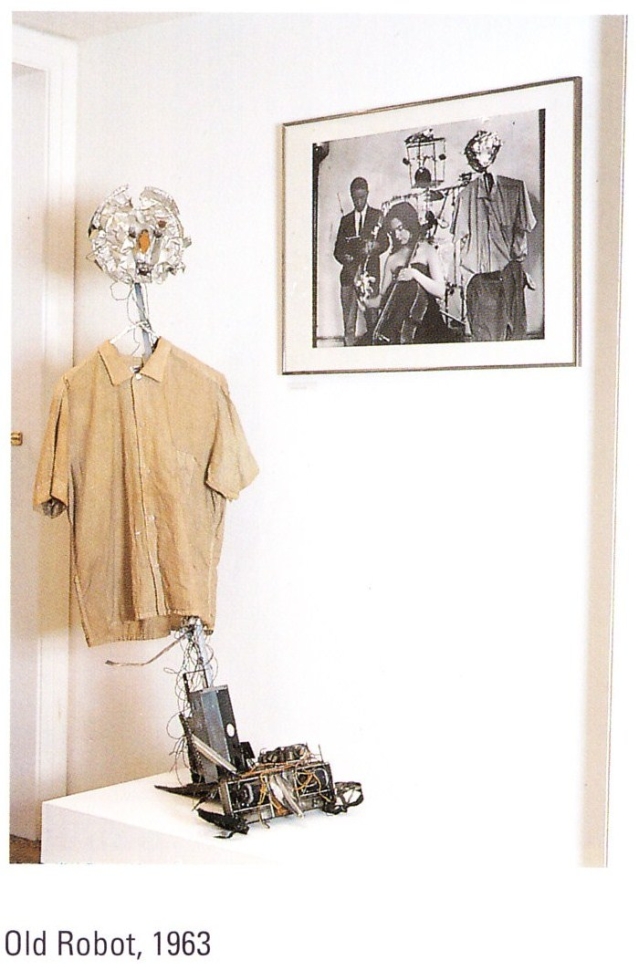
The New School brochure above mentions an act titled “3 Robots”. I suspect the “Old Robot” from 1963 was one of those robots, and later owned by Charlotte Moorman.
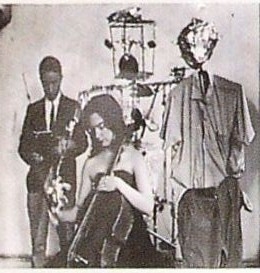



You can see the white beans on the floor after K-456 defecates.

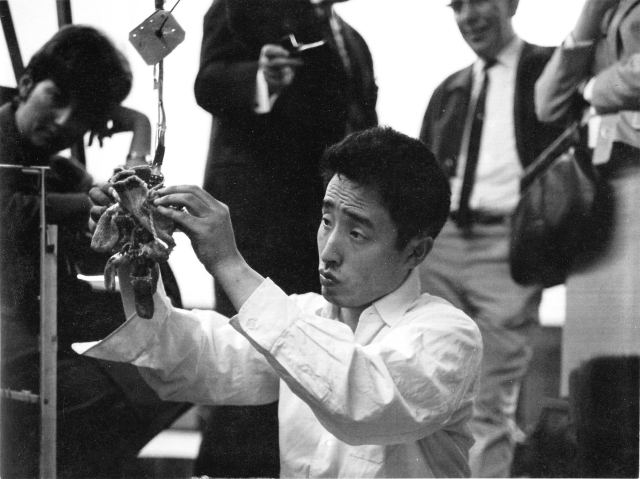
Wuppertal, 1965


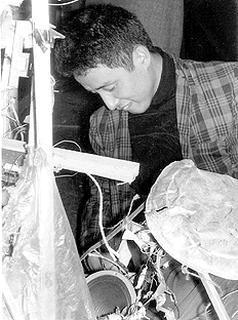
Art and the Future : Extract of Douglas Davis interview with Nam June Paik.
You say you left Germany in 1963. Where did you go?
To Japan, for two purposes. I wanted to make an electronically controlled robot and work with a color television set. I made a set with three cameras, feeding colors onto the same screen. I also made a spiral generator with Shuya Abe, the Japanese engineer, where you see a spiral on the screen. Since 1963, Mr. Abe has been my major collaborator in TV art. I cannot thank him enough.
Why did you want to build a robot?
I had read about robots in electronics magazines. I also discovered the equipment used in radio-controlled airplanes in Cologne, and I thought how to use it. I was dying to use every phase of electronics—audio, visual, tactile, and then radio controlled, a radio-controlled robot to walk the streets. So in Tokyo, I worked on the unit and made the robot. I had a thirty-channel control unit.
Did you think of the robot in any sense as a work of art?
I thought of it mostly as a Happening tool. I thought it should meet people in the street and give one second of surprise. Like a quick shower. I wanted it to kick you and then go on. It was a street-music piece. I took the robot with me to the United States in 1965, where it opened the Second Avant-Garde Festival that fall, in Judson Hall. Later I brought it to the streets of New York, to 57th Street, and then Park Avenue, and one sunny Sunday in Washington Square. All the people screamed when they saw the robot coming. One half-crazy black man screamed over and over: “God made this robot.” The happiest moment in my life was when I brought the robot to Washington Square: it was really a big sensation.

 Joseph Beuys (in hat) looks on. Robot is walking to the right.
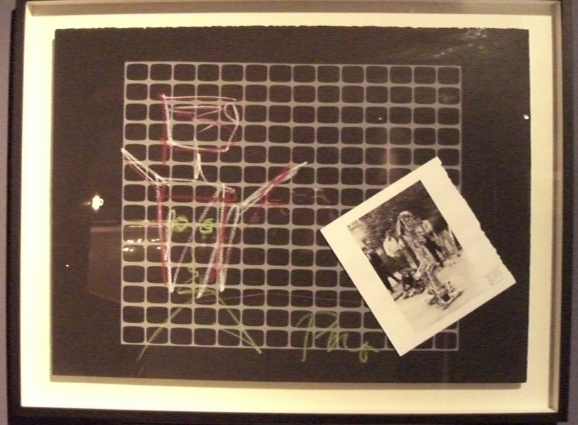

Nam June Paik here deploys his new ‘Robot K-456′, history’s first non-human action artist*. About the robot, which he built in Japan, Paik wrote: ‘It was more difficult and more expensive than my Wuppertal show’, by which he meant ‘Exposition of Music – Electronic Television’, the exhibition likewise staged in the ‘Galerie Parnass’ in 1963. The robot was purpose-built for street actions, in which it was supposed to mingle – more or less inconspicuously – with bypassers, as Paik recounts: ‘I imagined it would meet people on the street and give them a split-second surprise. Like a sudden shower.’
* – RH 2010-Â We know from our timeline that, in fact, there were earlier robot performers.
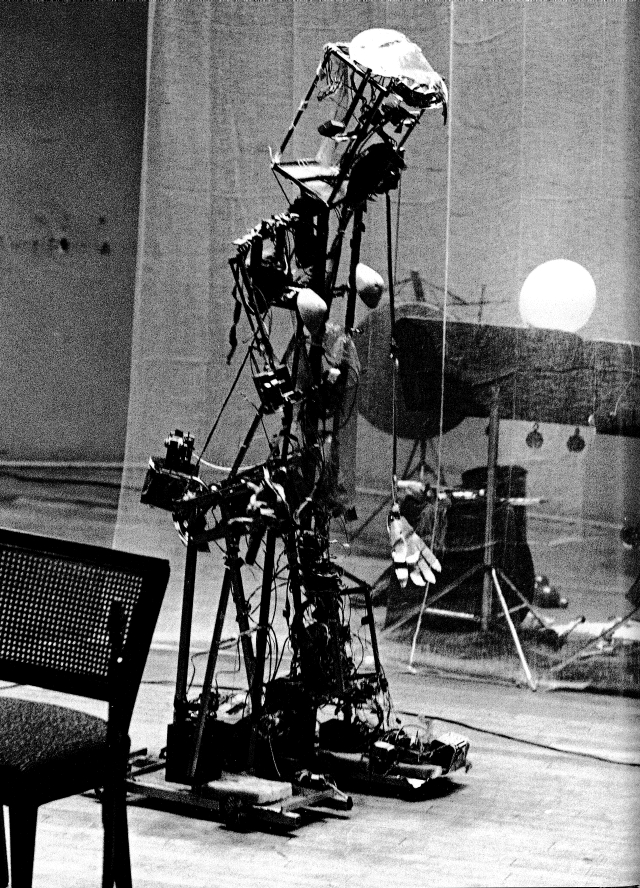
Robot K-456 in Robot Opera (1964) Judson Hall, New York.
Art in America – Nov/Dec 1974
The Avant Garde Festival : And Now, Shea Stadium by Peter Frank
….The artist with whom [Charlotte] Moorman has worked most closely is Korean-born Nam June Paik, a Fluxus-related musician and visual artist …….. Paik’s Robot Opera was the hit of the 1964 festival with K 456, its endearing mechanical androgyne, parading up and down in front of Judson Hall and performing with Paik and Moorman on stage.


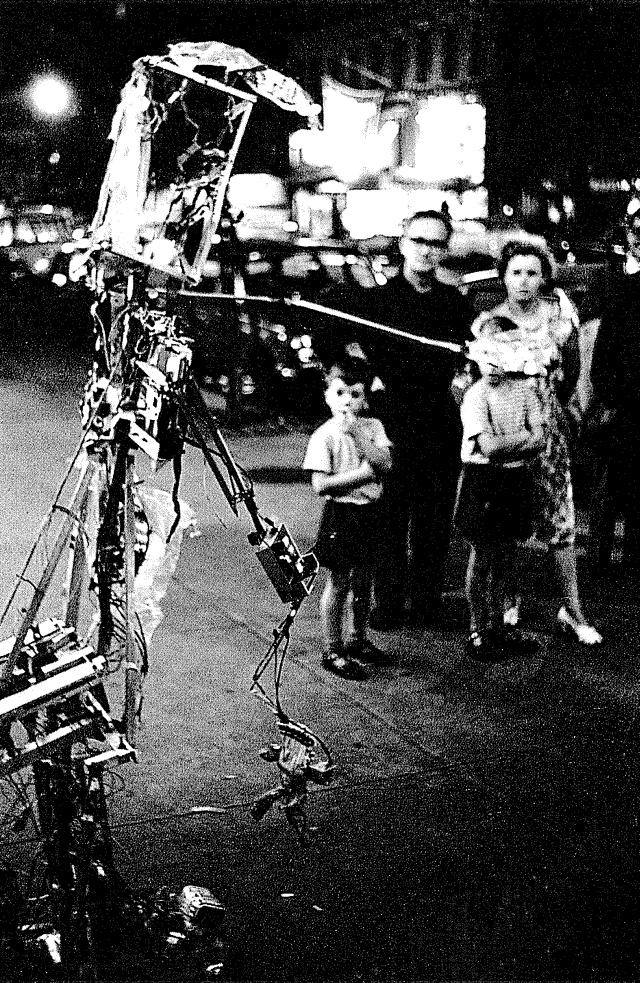
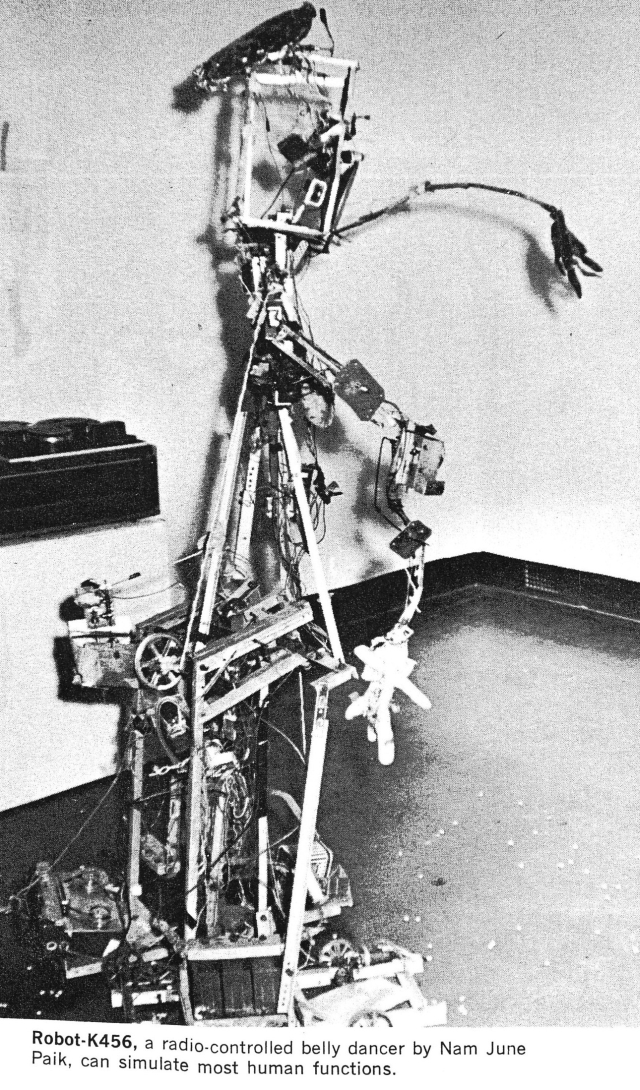
In the above photo, you can see the “white beans” on the floor representing defecated excrement.
Electronic Design, Vol. 14, No. 1
January 4, 1966
  During the past month, exhibits of electronic art have blossomed in New York with a frequency that suggests an aesthetic explosion in electronics or, at the very least, an electronic explosion in aesthetics.
  The word art is used advisedly. The creators of the works shown here do not represent these to be art in the classic sense. Not a single piece is fashioned of traditional material, nor with ordinary tools. In this new art, wire and junk iron replace marble and canvas; the welding torch and the screwdriver eliminate the chisel and the paintbrush.
  All of the works move and most of them make funny noises. In theory, there is no reason why art objects shouldn’t make noise, yet when the clatter of the other art completely drowns out the one you’re trying to listen to, you quickly develop a respect for quiet museums. The creators of these contraptions may or may not be competent artists, (history must decide that), but they certainly have senses of humor.
Marshall McLuhan, Canadian philosopher, observes that modern art is always one technology behind life.
This is amply illustrated by these electronic efforts in our nuclear age. But Oscar Wilde said, “Life imitates art” and, indeed, there are pop-art people who bend every effort to look like the chap in the bottom photo on this page.
………
The most electronically sophisticated work was produced by a Korean, Nam June Paik. His “Robot-K456” (see photo above) is directed by two 10-channel transmitters. Twenty radio-controlled mechanisms are powered by a battery on each foot. Robot-K456 can bow, walk, give a speech (recorded by the then Mayor-elect of New York, John Lindsay), lift each arm independently and wiggle its representational torso. It also defecates on the floor of the gallery by remote control.
Paik’s robot looks mechanically unreliable and he admits that it needs constant attention. It has crashed to the floor twice when taking too deep a bow, He made it for next to nothing. When asked if it could be improved, he said, “In electronics you can do anything if you spend the time and money.”Admittedly, these efforts merely represent a start. Whether the path will really ever be run or whether electronics artists will fade, as did the fist and shoulder pianists, is hard to predict.
Certainly these examples in no way approach the present “state-of-the art.” Perhaps a flurry of artistic activity among electronics design engineers will contribute to the culture as well as the technology of future generations.
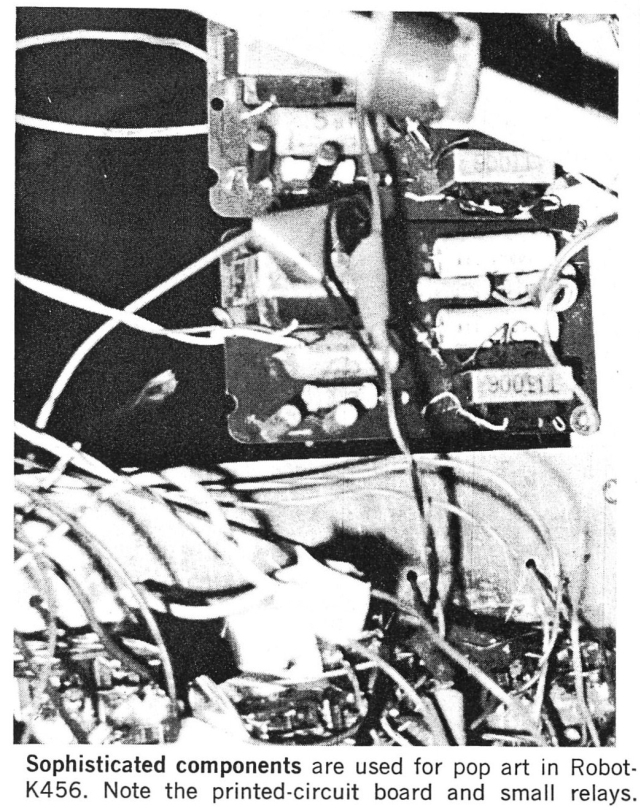

K-456 featured in the 1968-9 “Cybernetic Serendipity” exhibition.

You can just see K-456 in the distant background, between Bruce Lacey’s ROSABOSOM and MATE in the foreground.


Above: Image from the movie “A Tribute to John Cage”, 1973.
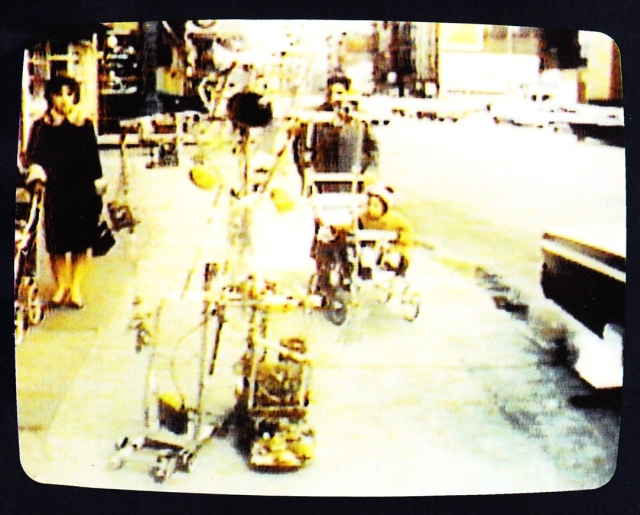


Jud Yalkut. Robot K-456 encounters the public on the streets of New York, 1965. From P+A – (K), a 16-mm color film. The film itself is dated 1966, and K-456 is walking down Canal Street one Sunday.
I don’t know if it was filmed, but K-456 took a stroll from the Galeria Bonino on 57th Street in 1965. (Nam June Paik:Electronic Art. Bonino Gallery (Galeria Bonino), New York, 1965 .)
from Focus: reading for success -  Richard L. Allington, Scott, Foresman and Company – 1985
During a show at a gallery in New York [Galeria Bonino], Paik decided to have some fun. He opened the door and aimed his robot for the street. “Mrs Bonino!” a nervous visitor cried to the owner of the gallery, “One of your sculptures is walking down 57th Street!”

Paik’s first solo exhibition “Electronic Art” in the USA at Galeria Bonino, New
York. 1965. Paik never sold a piece during his ~10 years with Galeria Bonino. However, Bonino gained media attention during that time, and Paik had an outlet to show his art.
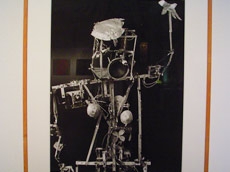
Paik needed some money to stay in New York. He decided to sell K-456. Here is a copy of a letter he penned to John Cage (c1970) regarding this situation:
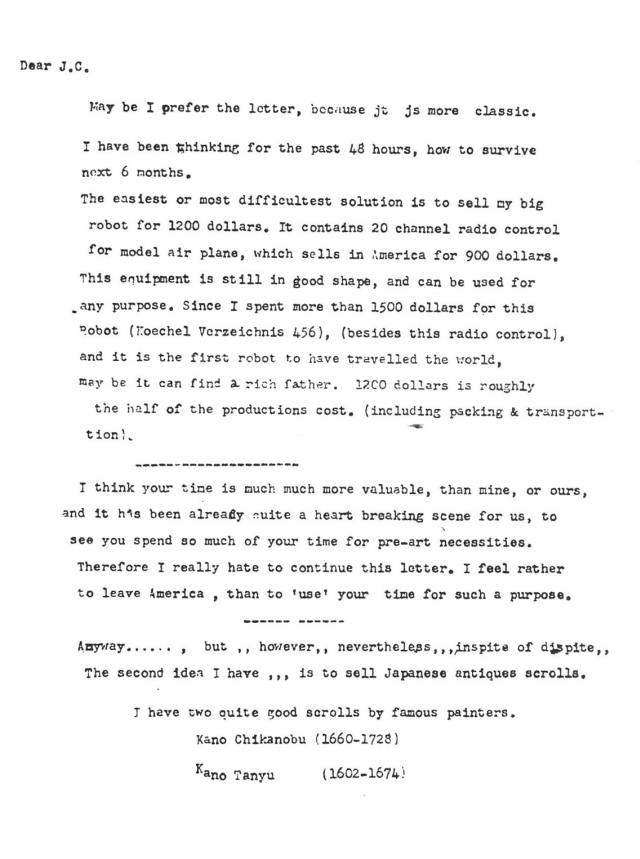
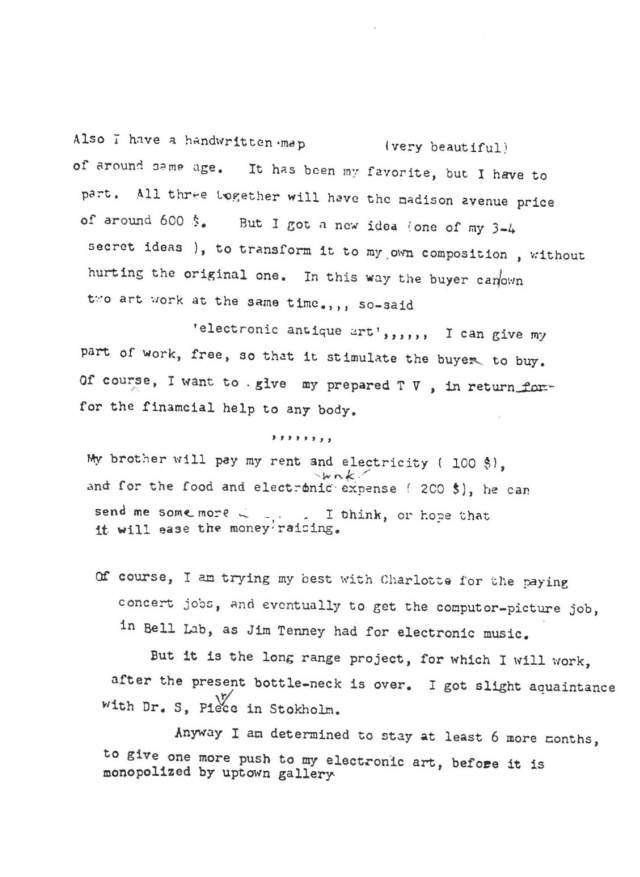
Extract of essay following Paik’s death in 2006 by John Hanhardt, Guggenheim Museum.
The Worlds of Nam June Paik is an appreciation of and reflection on the life and art of Nam June Paik. Paik’s journey as an artist has been truly global, and his impact on the art of video and television has been profound.To foreground the creative process that is distinctive to Paik’s artwork, it is necessary to sort through his mercurial movements, from Asia through Europe to the United States, and examine his shifting interests and the ways that individual artworks changed accordingly. It is my argument that Paik’s prolific and complex career can be read as a process grounded in his early interests in composition and performance. These would strongly shape his ideas for mediabased art at a time when the electronic moving image and media technologies were increasingly present in our daily lives. In turn, Paik’s work would have a profound and sustained impact on the media culture of the late twentieth century; his remarkable career witnessed and influenced the redefinition of broadcast television and transformation of video into an artist’s medium. ……….
In 1982, my longtime fascination with Paik’s work resulted in a retrospective exhibition that I organized for the Whitney Museum of American Art in New York.
…………. This introduction concludes with a photograph documenting Paik’s Robot K-456 (1964) in an “accident” staged in front of the Whitney Museum of American Art in 1982. Paik removed his remote-controlled robot from his retrospective exhibition at the Whitney and guided it up the sidewalk along Madison Avenue. As the robot crossed the avenue, it was struck by a car and fell to the ground. Paik declared this to represent a “catastrophe of technology in the twentieth century,” stating that the lesson to be gained from these tentative technological steps is that “we are learning to cope with it.” Paik’s staged event drew attention to the fragility of humankind and of technology itself.Twenty years after his first experiments with the television set, this street performance was made for television: after the performance, he was interviewed by television news reports; Paik took this playful moment as an opportunity to recall the need to understand technology and make sure that it does not control us. Paik’s staged event with his manmade robot was a humanist expression of a technology that subverted the dominant postinstitutions. Paik, who remade the television into an artist’s instrument, reminded us that we must recall the avant-garde movements of the 1960s and learn from their conceptual foundation, which expressed. the need to create alternative forms of expression out of the very technologies that impact our lives. Robot K-456 is a statement of liberation, demonstrating that the potential for innovation and new possibilities must not be lost, but must be continually reimagined and remade by the artist.
At some stage, K-456 was modified to accept commands for even more functions. The right leg now carries several banks of relays, and Paik uses up to 4 transmitters, all visible in some later images. One article I’ve seen [Douglas Davis] has Paik mentioning a 30-channel R/C controller [which was the intended number of channels of the original design].
“The First Catastrophe of the 21st Century”
Location: 75th Street and Madison Avenue, Manhattan, outside of The Whitney Museum. 1982.
Description: Staged accident in which the Robot K-456 was hit by a car
Commentary: For this performance, K-456 was removed from its pedestal at the Whitney Museum of American Art, which hosted Paik’s retrospective exhibition, and guided by the artist down the street to the intersection of 75th Street and Madison Avenue. When crossing the avenue, the robot was “accidentally” hit by an automobile driven by artist Bill Anastasi. With this performance Paik suggested the potential problems that arise when technologies collide out of human control. After the “collision”, K-456 was returned to its pedestal in the Museum.

( 3 photos here by George Hirose)


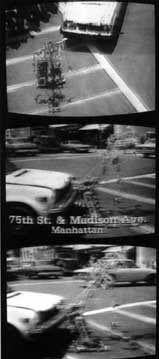
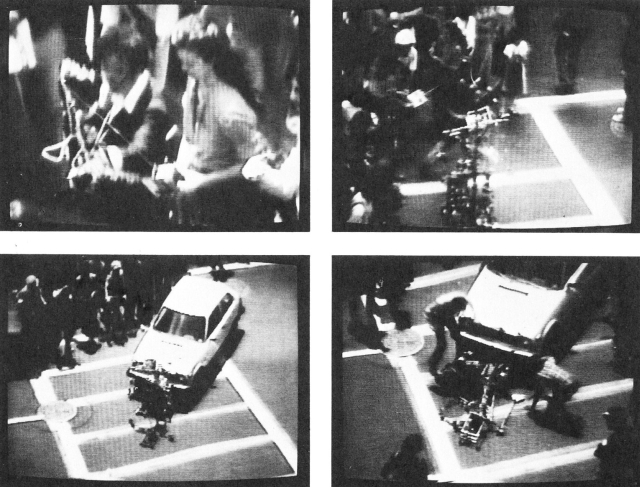
Vehicle driven by artist William “Bill” Anastasi.

Chance in a lifetime: John G. Hanhardt on Nam June Paik
ArtForum, April, 2006 by John G. Hanhardt
Only in part was Paik remaking and humanizing technology in a carnivalesque spirit of play and freewheeling invention. Consider his remote-controlled automaton Robot K-456, 1964, which he used in performances both onstage and in the street. Outfitted with tape recorders and a messy mass of wires snaking around a metal frame in a blocky humanoid shape, this comic mobile sculpture was featured in Paik’s Robot Opera as part of the Second Annual New York Avant-Garde Festival, which also took place in 1964, the year Paik moved to New York. Robot K-456 shuffled down the sidewalk, playing political speeches by John F. Kennedy and, as Paik would say, “shitting” beans out its backside. When I organized Paik’s 1982 retrospective at the Whitney Museum of American Art, Paik set Robot K-456 in motion again, this time down the sidewalk and across Madison Avenue, where a car ran into it in a staged accident. When a television reporter asked Paik what had happened, he replied, it was the “catastrophe of technology in the twenty-first century. And we are learning how to cope with it.”
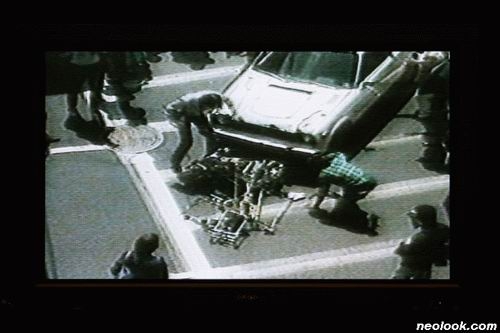
K-456 knocked to the ground. I wonder if the owner’s knew that that was going to happen to their prized possession!
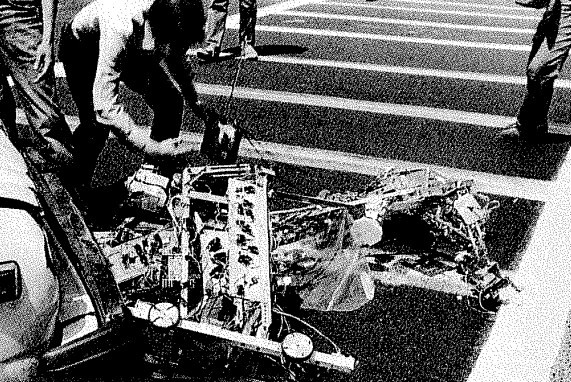
Merce Cunningham: the modernizing of modern dance By Roger Copeland ,2004
9 Dancing for the Digital Age – p202
These “inanimate movers” in Cunningham’s work may well have been inspired by Nam June Paik’s growing interest in robotics during this same period of time. In 1960, Paik became fascinated with wireless remote-control devices such as children’s cars and model airplanes. Four years later, in 1964, Paik presented a public performance featuring his Robot K-456, a human-sized automaton constructed from metal and wire. But Robot K-456, unlike the robots in much of science fiction and Hollywood fantasy, is no lean, clean, fighting machine. K-456 was a rather vulnerable-looking, sticklike creature who resembled an ordinary human more than a Robo-Cop style cyborg. (On occasion, K-456 even “defecated” a trail of dried beans.) The robot’s fragility was most poignantly dramatized nearly two decades later, in 1982, as part of The Whitney Museum’s Nam June Paik retrospective. Outside the museum, at the intersection of Madison Avenue and 75th Street, Paik staged what he called “The First Catastrophe of the 21st Century.” As he guided K-456 across the avenue via remote control, the robot was hit—and mangled—by a car. The driver was the visual artist William Anastasi…………
“The First Catastrophe of the 21st Century” recalls Cage’s comment about Rauschenberg: “Now that Rauschenberg has made a painting with radios in it, does that mean that even without radios, I must go on listening even while I’m looking, everything at once in order not to be run over?” (1961).
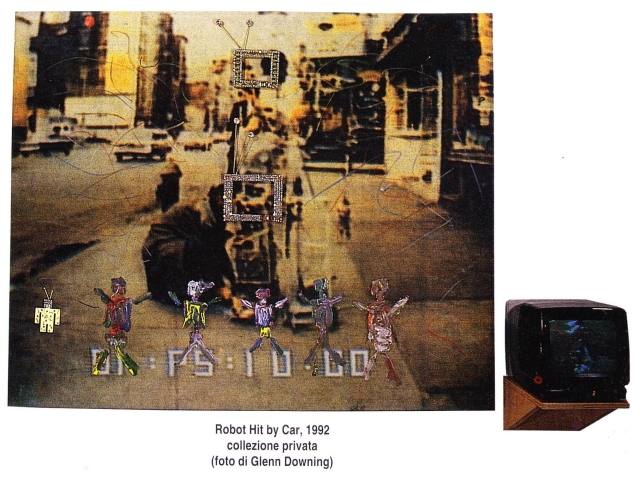
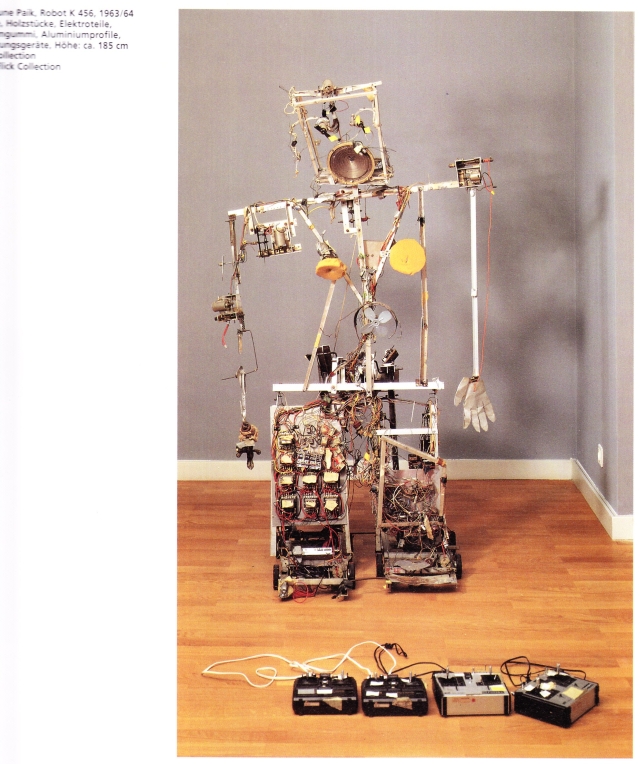
You can clearly see the extra electronics and relays in K-456’s right leg. I’m not sure when these were added, but at least from 1982. The four transmitters can be seen in the foreground. The paper notes stuck on the transmitter controls would be to name and hence match the command to the corresponding function as labelled on the relays on the legs.
Further, from my first-hand  knowledge of Bruce Lacey’s ROSABOSOM built in the same era, he had to upgrade from the earlier Radio Control technology (being pulse/escapement-type receiver/transmitter combinations to the now proportional/servo type transmitters. Lacey simply added servos to operate the existing on-off relays. So maybe most, if not all, the additional electrics and electronics as seen on K-456’s right-leg are to marry the two different technologies. All the four transmitters in the above photo appear to be ‘modern’ proportional controllers. Someone out there probably actually knows for sure. Maybe they could contact me or post a comment to advise further.
Speaking of Bruce Lacey and his ROSABOSOM, I find it ironic that Lacey built ROSA as a reaction to Concrete poetry by Paiks contemporarys, to use Lacey’s words “take the piss”, whereas Paik built K-456 exemplifying the Fluxus objectives, and has the basic functions to eat, shit, and piss on you!
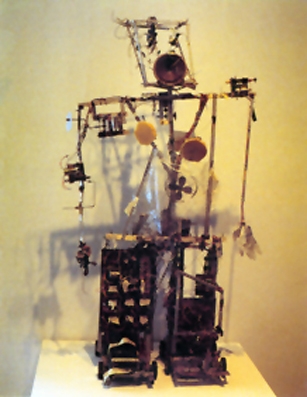
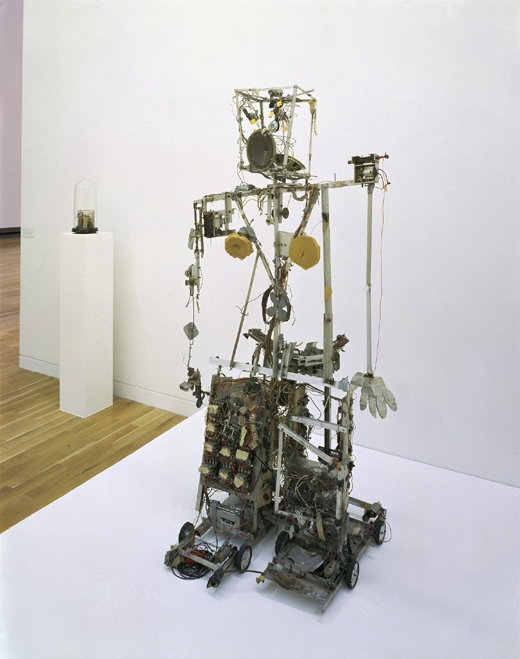
Robot K-456 in the Flick Collection. Foto: S. Rötheli, Zürich
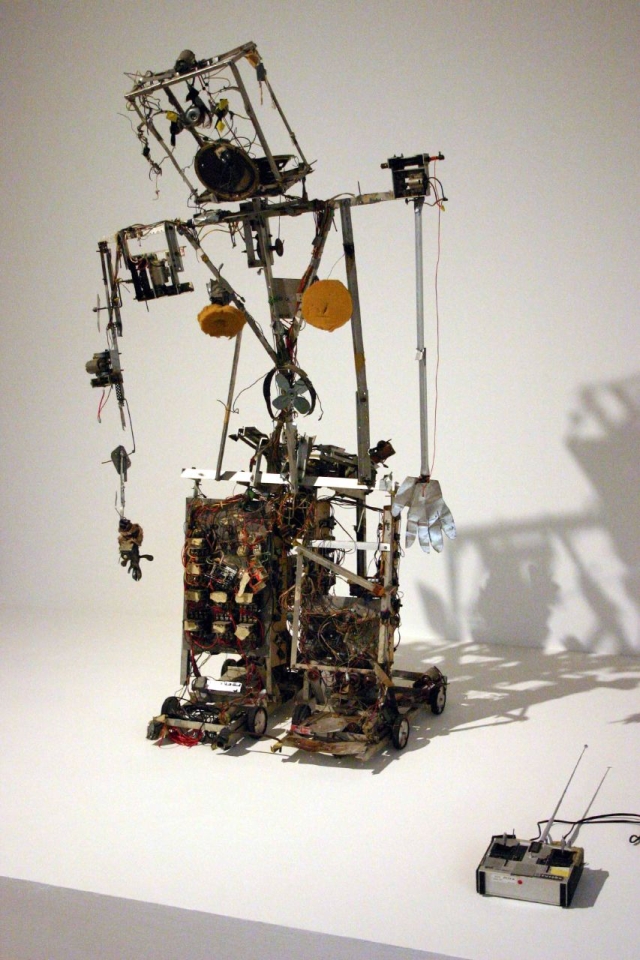

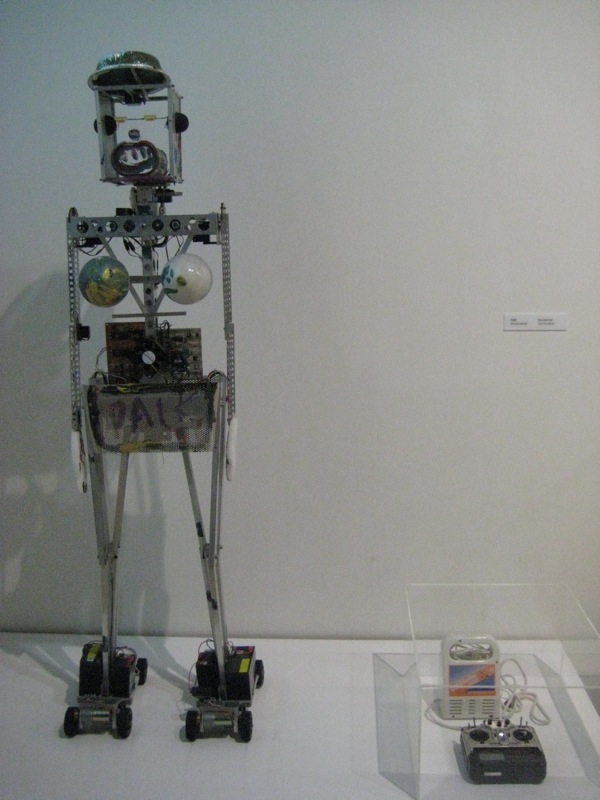
It’s unclear to me whether or not these modern K-456 look-alikes are Paik’s or made in hommage to Paik. If someone knows, maybe they could sent an email or post a comment to enlighten us all! The exhibition is in Korea.
‘frontjang’ from comments below says “it is known that the newer one is made by Paik himself in 1996, the same year he had a stroke.”
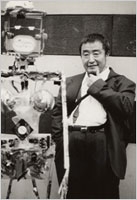
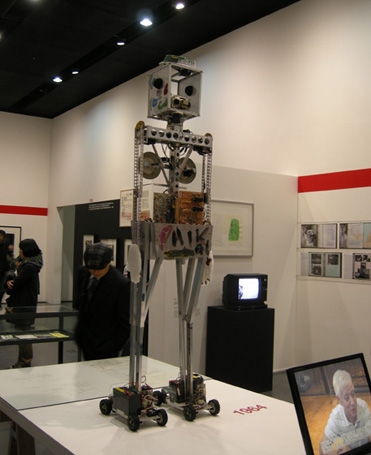
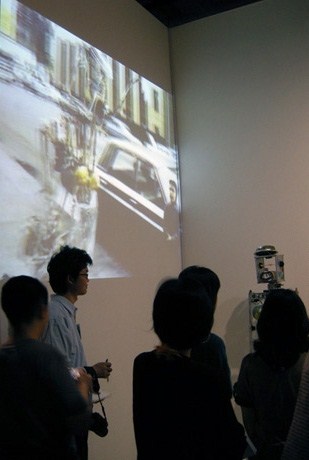
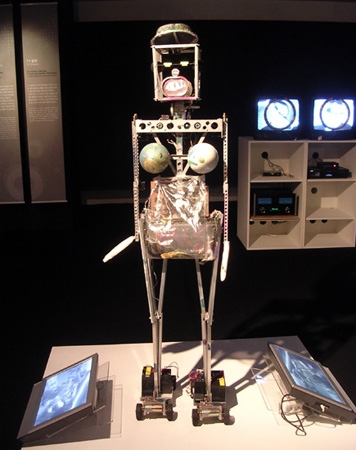
(I don’t know who to credit for the above images)
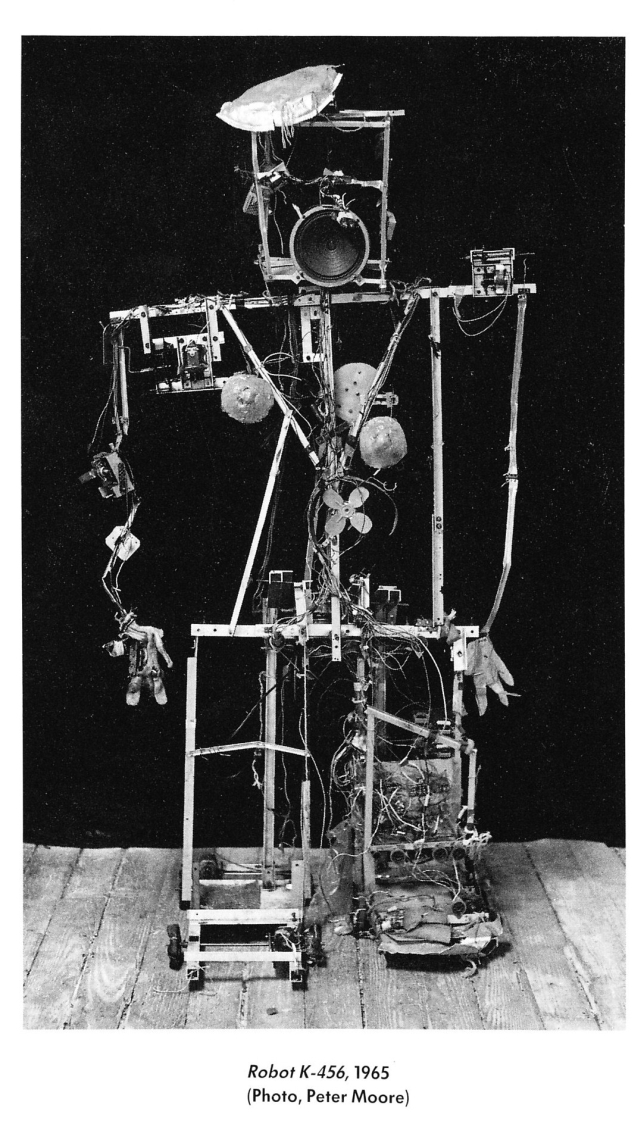
Quite extensive and excellent article on Paik’s robots written by Wulf Herzogenrath. Extract from Hayward Gallery 1988 exhibition catalogue “Nam June Paik Video Works 1963-88”.
The Robot K-456, 1963/64
The ‘simultaneity of the other’ suggested here, to adapt an exhibition title by Jürgen Glaesemer9, can be charted particularly clearly with reference to one theme: the theme of the robot.
The simultaneity of too fast and too slow, or the idea of working simultaneously on an installation with 382 running TV sets (Tricolor Video, Pompidou Centre, Paris, 1982) (page 20) and on an old TV cabinet, empty of
19
technology, decorated only with a burning candle (page 29) — these oppositions can also be seen in the comparison of the Robot K-456 of 1963/4 and the Family of Robot he produced some twenty years later. For Paik, apparent contradictions are part of the unity of the work: only the next phase in a video tape determines the significance of what has gone before, only the sequence of images in the monitor can reveal the meaning of the sculpture. For that reason I want to discuss the early robots that Paik started to make in Japan at the end of 1963: the famous Robot K-456, frequently used and photographed (now part of the bequest of the late Wolfgang Hahn in Cologne); a second, more simple version owned by Charlotte Moorman; and a third ‘nude model’ now in the possession of Paik himself (page 23[similar to above]) [see Note-**]. As early as 1960 he became fascinated by the possibilities of wireless remote control of aeroplanes, ships or children’s cars. He tells enthusiastically10 of how he visited a toy shop in Cologne and a specialist do-it-yourself shop selling electronic components, in order to inform himself and to familiarise himself with the low cost technical possibilities.
After his arrival in Tokyo in 1963 he began to build the first robot with his brother. It was to be remote controlled via 30 channels, so that it could walk, talk and move its arms. But it turned out to be very complicated to get even
20
twenty channels working side by side. Shuya Abe helped him with the technical details.
Paik wanted to build an anthropomorphic robot, because he was fascinated by the scientists’ discovery that the human brain had begun to grow after man stopped walking on all fours and had to figure out what to do with his two ‘free’ hands. Walking upright posed the greatest problem for the robot’s constructors, for during any fairly rapid movement the point of balance had to remain in the centre, so that the only movement possible at first was smooth rolling over level ground. Paik wanted a robot that could stride forward. To these complicated functions — walking forwards and backwards but also turning to right and left — was added speech, for the head of Robot K-456 was controlled by a loudspeaker, playing an audio tape.
At first Paik planned to record his own texts, but soon he changed his conception and let the robot utter important statements by politicians, which one was accustomed to hearing on the radio. John F. Kennedy’s appeal to his fellow citizens to ask not what their country could do for them but what they could do for their country, as well as excerpts from speeches by Churchill and Hitler, could be heard in the streets when the robot was out and about. The premiere took place on August 30th 1964, at the Second Annual New York Avant-Garde Festival in the Judson Hall, organised by Charlotte Moorman.11 The Fluxus character of the robot can not only be read from its appearance (re-used ‘poor’ materials), or heard in its words (politicians’ statements which have acquired a life of their own), but also seen from its actions. Paik regretted that for all robots the problem of digestion was suppressed; by remote control K-456 excretes dried beans, which are easier to clear up than rice. Here the robot refers to Paik’s own role: the first stage direction for his piece Simple of 1962 instructs the performer to throw beans into the audience12; and during his own appearance in Karlheinz Stockhausen’s Originale at the Theater am Dom, Cologne in 1961 Paik had himself thrown beans. Paik, the robot’s friend, also thought about sex: K-456 is female with two breasts; a sort of penis made from sandpaper and flint was removed in Japan, not only to avoid any unwanted suggestion of androgyny but also because it seemed in bad taste. For all its humour and playfulness, the social aspect of K-456 should not be forgotten. Paik is proud of having constructed a robot which, instead of taking away human jobs, created them. For this fragile robot needs at least four people to accompany it, operate it and bring it to life.13 It also likes travelling and is a symbol for the international unity of Fluxus ideas and for the question of
21
the human dimension of technology. In 1965 the robots wandered around New York, visiting Washington Square, among other places, and gave out a leaflet entitled Robot Opera, which contained several Fluxus statements which referred particularly to the Met opera and to soap opera.14 Here Paik also gave a concealed clue to the meaning of the ‘K’ in the robot’s title; it refers to the Köchel-Verzeichnis of the works of Mozart, in which K-456 designates a relatively unknown piano concerto.15 But this reference to the musical context becomes clear when one reads the concluding words of the leaflet: ‘time, date, place, audience: INDETERMINATE’ — which is a homage by Paik to the respected master of new music, John Cage, who perceives the noises of everyday life, of the activity in each particular space, as the real music; who incorporates chance and uncertainty, the individual structure. In the leaflet Paik declares himself to be against the increasing currency of the art object as commodity: a young artist defines his position towards the older generation: ‘Pollock is too sad — Pop art is to pop’s … Awake! C’est déjà midi!’
In 1965, with this anti-technological technology16, this poor sculpture from rich New York, Paik travelled, via Iceland — the cheapest way — to Paris. He still remembers with horror how the crate seemed to have got lost in the freight hold and only turned up in Paris several days later. Paik appeared with Charlotte Moorman, and sometimes with the robot, notably on 5th and 6th June, 1965, at the most famous German happening, 24 Hours, at the house of the Wuppertal architects the Jährlings, together with Joseph Beuys, Bazon Brock, Ute Klophaus, Eckart Rahn, Tomas Schmit, Wolf Vostell. In the small format documentation with photographs by Ute Klophaus one can see Paik leading his robot through the streets of Wuppertal. In the documentation Paik published a text entitled Pensée 1965, which in its aphoristic and apparently paradoxical form, and consciously in its title, was a kind of continuation of the Pensées of Pascal. He quotes (in English) a reply he made to Allen Ginsberg: “Perhaps my minority complex as an Asian or a Korean drives me to compose the very complicated cybernetic arts”.17 He sees the future as a time of less egocentricity, less nationalism and toil, with more leisure; a cultured leisure, like that of the slave owners in ancient Greece -but this time the slaves will be robots. He describes his own work, in contrast to the pop art he labelled ‘rich’, as poor art, like that of Cage, Stockhausen and Cunningham. This seems to have been one of the first references to the concept of poor art, for in 1965 Italian arte povera did not yet exist as a name, indeed the works were only just being created at about this time. He predicts the replacement of heavy industry by the electronics industry, which
22
would be paralleled by the gradual freeing of the idea, the pure thought, from the material. These formulations precisely anticipate later developments. They apply not only to arte povera, to the poeticisation of material and to conceptual art, but also specifically to video art, which cannot be established as a unit in the art market, but which, as an idea, transmitted by television, exercises a supra-national and non-material fascination. From the elitist video art tape to the popular promo for a rock band, from the studio of an artist to reception by millions, from the Serious artist, who makes serious art for the few, to the Entertainment artist, who fills millions with enthusiasm.18 These aphoristic hints in the text Pensée can be seen, like Pascal’s text, to mark a conversion, the basis for a new attitude.
Later, at the invitation of René Block (Sixth Soirée, 14.6.65) the robot visited the Brandenburg Gate in Berlin, and travelled to an Art and Technology Festival in Stockholm. It crossed the Atlantic two or three further times, the last time to appear at Jasia Reichardt’s epoch making exhibition, Cybernetic Serendipity at the London ICA in 1968 — for which Paik published his text Expanded Education for the Paperless Society. All this travel was too much for the robot, who had to crawl off into a crate, which was how it was exhibited in the retrospective at the Cologne Kunstverein, like a mummy from a past age. Visitors looked with reverence into this wooden box filled with strange metal parts, wires, loudspeakers etc. Had this mess really once been a robot, which had made the front page of the Daily Mirror as recently as 1968? What had changed? Robots by this time were working in almost all branches of industry, making many jobs superfluous, but they could also be used where stupid or hazardous work would have been pointless or dangerous for human beings. Major operations in manufacture or storage are inconceivable now without robots — and the discussion about genetic engineering, the possibility of manipulating human genes, has begun to become a hotly debated subject in the 1980s.
Family of Robot, 1986
Seen in these terms the subject of robots has lost none of its topicality. There are two different strains of robot life: on the one hand the mechanical man, the automaton, who, driven by human power, produces music or draws19; on the other hand, there is the tradition in England of horror stories with artificially created men. The twenty year old Mary Shelley’s Frankenstein or the Modern Prometheus became the prototype for a whole genre; it appeared in 1818 and became an enormous success immediately20.
24
Paik combined both these strains of robot prehistory in his Robot K-456: the automaton who produces music, sounds and speeches, who playfully carries out Paik’s critique of social development in such actions as the bean throwing — and the artificial man filled with longing, seeking out his own kind, who then gets knocked down by a car on Madison Avenue and has to be carried back to the Whitney Museum on a stretcher. This, which Paik likes to describe as the ‘first 21st century accident’ — happened under the gaze of the media during Paik’s Whitney retrospective in 1982. The longing of the recovered robot to find his own kind remains unsatisfied — but perhaps that was what made Paik conceive his Family of Robot.
Paik has realised his most comprehensive artistic concept: in 1986 the Family of Robot consisted of grandparents, aunt and uncle, parents and
25
three children; in the meantime five more children have arrived — almost all of them found their way very quickly into prominent public or private collections. The last and youngest child was donated by Paik to the New York non-profit making foundation ‘Artist to End Hunger’, Inc.21
Since the early seventies Paik has used the wooden cabinets of ‘antique’ TV sets from the forties and fifties, removing their insides and filling them instead with aquaria with live fishes, or drawings, or video cameras, or even a single candle (page 29 [not shown]), thus turning them into media-critical, ironic, many-layered sculptures. The design of TV sets, the objects of the future, rapidly comes to look dated and nostalgic, making it possible to see the rapid transformations in technology: the early models take over forms from architecture, in particular from theatre design, but also Gothic elements, associated with religion.22 On these old sets, some of which are in fact only radios, we now see not the poor quality black and white pictures we might expect, but fast moving, new colour sequences, which Paik creates specially for each new family member, to be presented on the brand new, technically up to date screen.
These robots can still be moved on rollers, but not by remote control. They don’t throw beans or make political speeches, but offer permanent, synthetic colour TV images, composed by Paik for the particular individual, but without sound; on all monitors is the same tape, often turned sideways or reversed. These are not robots that induce fear. Instead like the Robot K-456, they have a lovable, rather antiquated charm. Paik has gone so far as to characterise each of the generations. The grandparents have as heads a radio set that was more than ten years out of date, in order to show how the old people lived in the past; father and mother in contrast have been given large, fairly new TV tubes as heads, so that they look confidently into the future, like the uncle and aunt (page 28). The children are made mainly of new metal sets and small TV tubes. The identical nature of the sets produces a critical impression of uniformity — although the eldest child is made up of bakelite sets from the 50s, but with a very modern TV as a head.
Since the beginning of the 80s Paik has often built large structures out of individual TV sets, most impressively perhaps with the sculpture V-Yramid of 1982, which is now in the Whitney Museum of American Art in New York. But the outer lines are always large geometric or stereometric forms; the visual, the artistic element lies in the arrangement of the often angled video screens, some of which are often turned sideways, and the video compositions the arrangement produces. Forms of objects, figurative outlines, had never figured in Paik’s work before, just as he had always used single sets
27
until now. Now it is the assemblage of several sets that creates the main visual impression and the video images become simply one element in the overall appearance of the work. One can see in this a closer connection with the history of sculpture, less concern with the development of video tapes. TV pictures no longer fulfil a need for information, but are degraded more to the status of a decorative addition — as in breakfast television and the increasing emphasis on ‘entertainment value’ in TV in general.
The notion of Assemblage points to a tradition in sculpture of the last 100 years. Paik excludes from his work the surreal combination of apparently unrelated things. It is clear to every viewer that all the parts of these sculptures come from the same field of radio and television electronics: radios and TVs, antennae, picture tubes, loudspeakers and similar things. The combination alone makes the objects seem strange, turning a former
28
Emerson radio of 1938, with the manufacturer’s name ‘Mae West’ into a rather high bosom.
That the sculptures are actually more like reliefs is a product of the materials’ use and function as TV equipment, whereby they are seen only from the front, so that a side view is uninteresting, while a back view, more ironically, is a banal unveiling of the front view which transmits the image.
These rather quirky, droll members of the Family of Robot have lost the terrors of Frankenstein’s monster, not only because they have found their own kind and become a loving extended family, and because they have become more like people than the invented monsters of the 19th and 20th centuries ever could. For are not our experiences, our images and memories today determined increasingly by electronic representations? Are not the events we remember often events shown on TV? In the last few years this has become even more pronounced, as many millions of people record their family and holiday pictures with their own home video equipment. Seen in this way the members of the robot family are very familiar to us. They are not so much images of the threat posed by the machine robots who take our jobs, but relatives. They seem to have freed themselves from the human basis of personal communication and developed into an assemblage of
29
prefabricated memory, life which has sprung ready formed, in colour, from the electronic test tube.
They are the nice relatives whose flesh and blood equals we are increasingly becoming, or perhaps have already become. Seen in this light, these images of people are more malicious and revealing —for they are images not of robots, but of us, of people of the electronic age at the transition to the 21st century. With these friendly, harmless, nostalgic, playful forms, Paik has created an image of man, which, with its collaged surrogates and predetermined pictorial pattern, is frightening and subversive. He uses electronic means in order to expose those means ironically — here too we can see a trace of the anarchist influenced by Zen, who finds seduction so natural. ‘One must’, Paik once said, ‘know technology very well in order to be able to overcome it’. And it is the joy of the thing, and only the joy, not the moralistic pointed finger, that can bring this victory, pervading and transforming the world; an effective humanisation of technology.
30
Notes
1. The first chapter is a revised version of my introduction to the exhibition catalogue Paik, Cologne Kunstverein, 1976, pp. 7-11.
2. I have referred in what follows to the most important literature on Paik. On the subject of time, cf. Wulf Herzogenrath, ‘Zeit bei Dan Graham und Nam June Paik’, in Zeit – Die vierte Dimension, ed. Michel Baudson, Acta Humaniora der VCH, Weinheim, 1985, pp. 248-253.
3. Edith Decker, Paik, Video, Cologne, 1988. This is a slightly revised version of her dissertation (University of Hamburg, 1985). It contains a comprehensive bibliography.
4. Paik’s relationship with the art and music scenes in Cologne is documented in the
exhibition catalogue Die 60er Jahre- K̦lns Weg zur Kunstmetropole РVom Happening zum
Kunstmarkt, Cologne Kunstverein, 1986, pp. 142-169.
5. Decker, op. cit. pp. 21-23.
6. Treffpunkt Parnass Wuppertal 1949-1965, ed. Will Baltzer and Alfons W. Biermann,
Cologne, 1980, pp. 192-197, 208-215.
7. Charlotte Moorman deserves a whole study to herself, but this remains to be done. cf.
Wulf Herzogenrath, Paik, Fluxus – Video, Munich, 1983, pp. 58-65. The quotation is on p. 62.
8. Some of the letters to Cage are reprinted in Nam June Paik: Videa ‘n’Videology 1959-1973,
Everson Museum of Art, Syracuse, New York, 1973.
9. Jürgen Glaesemer produced an extensively impressive publication to accompany the exhibition of the same name at the Kunsthalle in Bern in 1987.
10. This, like any other quotations for which no reference is given, is from a conversation between Paik and the author, Cologne, 1987.
11. Nam June Paik, Exhibition Catalogue, Whitney Museum of American Art, New York, 1982, p. 31.
12. The score of Simple, 1962, is reprinted, together with other early Fluxus pieces in the
exhibition catalogue Nam June Paik – Werke 1946-1976, Musik, Fluxus, Video, Cologne
Kunstverein, 1976, p.45.
13. There is a summary in Brian Morris, Die Welt der Roboter, Frankfurt am Main, 1986.
14. Reprinted in the Whitney Museum exhibition catalogue (cf. note 11), p.95.
15. Quoted in an undated letter (probably from 1967) in the Everson Museum of Art catalogue (cf. note 8).
16. This is one of the most frequently quoted of Paik’s remarks, along with ‘I make technology ridiculous’ (from an interview in 1975).
17. Reprinted in a small collectors’ edition documentation published by Hansen & Hansen, Itzehoe-Vosskate, 1965, and in the catalogue Treffpunkt Parnass Wuppertal (cf. note 6), pp. 287 and 289.
18. Wulf Herzogenrath, ‘Kunst zwischen E und U – Die neuen Strategien der Künstler’ in exhibition catalogue documenta 8, vol. 1, pp. 52-64, Kassel, 1987.
19. cf. note 12, and the exhibition catalogue The Machine as Seen at the End of the Mechanical Age, Museum of Modern Art, New York, 1968, pp. 14-28.
20. Mary Shelley, Frankenstein, oder der moderne Prometheus, Munich 1970. Mary Shelley, Frankenstein or, the Modern Prometheus, London, 1985.
21. Exhibition catalogue, Nam June Paik, Family of Robert, Carl Solway Gallery, Cincinnati, 1986. Text by Solway, illustrations, and brand names of all equipment used in the sculptures.
22. cf. Decker, op. cit, and Herzogenrath, loc. cit. (note 5).
31
Note: ** RH Aug 2010 – although insightful, I’m unable to corrobate parts of this claim. K-456 , to me, is the same as the so called ‘nude model’. The 1965 exhibition indicated ‘3 Robots’ in the program, but I’ve only ever seen images showing just two (as shown in this post).


Robert Rental’s Paralysis/ACC single, Company-Regular Records, 1978
(featuring Nam June Paik’s K-456 on the cover)Â from here.
Thanks frontjang, I’ll update my post with that information.
Cheers, Reuben (cyberneticzoo.com)
thank you for your intensive research on his work. it is known that the newer one is made by paik himself in 1996, the same year he had a stroke.